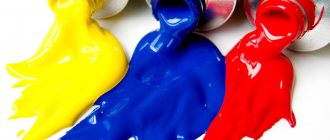- Tags:
- Parent lecture hall
- 1-3 years
- 3-7 years
- 7-12 years
For the most part, children love to draw. For them, this is one of the few ways to express their own thoughts. Often kids don’t even know how to speak properly, but they already enjoy getting dirty with paint and creating their own masterpieces that only they can understand. Each children's drawing is endowed with a huge number of symbols. For every detail drawn, you can say a lot about the child’s inner world, his feelings and ideas about the world around him. But mood and feelings are most clearly visible in the use of colors. Preference for one color or another is a diagnostic parameter and is used in professional psychological diagnostics. One of the most famous color tests is the Luscher test. We will not reveal the intricacies of color psychodiagnostics, but we bring to your attention a fairly simple color analysis of children's drawings of preschoolers and primary schoolchildren.
Green color
Color speaks of the mind and intelligence of a child who tries to find an explanation for all events and phenomena. Why color? Such children are interested in intellectual and logical games, crosswords, and puzzles. They have a tendency to boss others around. They strive to achieve their goal. Children who choose green, as a rule, are not afraid of new surroundings. Sometimes they are touchy. It is important for parents to teach such children to express their emotions, to be open, and to show more affection towards them.
Features of the development of children's color perception
We all want our children to grow up healthy and well-developed, so parents are often worried when their children have difficulty distinguishing colors, do not know their names, and cannot say what color this or that object is. This anxiety is understandable, but often unfounded, because the development of color perception in a child is gradual.
From birth to 3 years
This is a very responsible age not only in terms of physical development, but also in terms of children’s knowledge of the world around them. The brain of such a baby receives and processes a huge amount of varied information. There is such a point of view: if all the knowledge, all the experience accumulated by a person during his life is divided into two, then half will be in the first three years of life.
In the first months of life, the baby's perception is still very imperfect. For example, visual perception develops gradually over 6–8 months. This is not due to the imperfection of the visual organs, but to the ability of the brain to analyze images. And in the development of this ability, a child’s diverse environment, including color, plays a huge role:
- bright toys;
- rattles;
- colorful wallpaper on the walls of the children's room;
- curtains;
- cloth.
All this attracts the baby’s gaze, forces him to concentrate, examine, and develop his visual perception.
However, until the age of 3, the baby does not yet use his vision to its full potential; color attracts his attention, but is not associated with objects, which the child distinguishes by shape and not by color. And the baby still sees few colors, mainly shades of yellow, orange and red. And he will learn to distinguish other colors from the many colors of the world only by the age of 5.
3–4 years
This is the age of active games in which the baby masters the objective world. It is at this age that color becomes an important characteristic of things and part of ideas about the world. True, for now, for a child, the brightness of the shade is more important than realism. So red horses, green dogs, and blue pussies appear in children's drawings. After all, brown, gray and black colors are so boring!
However, it is at this age that correct ideas about the color scheme of objects should be formed. Because this is an important period for the formation of sensory standards - stable ideas developed by humanity about the characteristics and properties of things and phenomena. This also applies to flowers.
By the age of 3–4 years, a child is able to distinguish between 5–6 colors and begins to pay attention to the color characteristics of objects. Therefore, he can explain the “wrong” coloring of objects in his drawing in a very original way, with imagination: the green horse is like that because it was lying in the grass, and the blue one drank some water; a pink pussy because she wants to be beautiful, and an orange bunny because you can’t see white on a piece of paper.
At this age, kids are interested in the color of toys (“I don’t want a green car, but I want a red one!”), look at colorful pictures in books with pleasure, and enjoy bright clothes. And when they paint the walls or their arms and legs with felt-tip pens, children sincerely want everything around them to be beautiful.
Although children are good at distinguishing colors, they may still confuse their names, especially when it comes to similar colors, such as red and orange or yellow and orange. And sometimes people get confused about the colors themselves. So, for most children of primary preschool age, red and orange are the same color. And dark blue and light blue are completely different. The first is perceived as dark, does not evoke positive emotions and is rarely used in drawing. But blue is rated as light and positive, although in popularity it undoubtedly loses to red and yellow.
Some children under 5 years of age have difficulty remembering colors. Until the age of three, children often do not associate the name of a color with the color itself. And a blue or green ball can be called red. And often the word “red” for kids becomes synonymous with “beautiful”, or even “pleasant”, “good”. A stable connection between the names of colors and a specific color has not yet been formed. But this is a temporary phenomenon.
5–7 years
By the age of 5–6 years, the child’s cognitive sphere is already quite developed, he knows a lot, knows how to analyze information, compare, and draw conclusions. It’s not for nothing that children of this age are called little thinkers and dreamers. The inexhaustible curiosity of children is manifested in everything, including the desire to know the color of objects, the reasons for its change, and the peculiarities of mixing colors. Thus, children are delighted with the discovery that by mixing blue and yellow paint they get green.
In addition to primary colors, a 6–7 year old child distinguishes many shades and strives to know their names. After all, the process of cognition is closely related to speech activity.
Along with the cognitive function, color begins to perform an aesthetic function at this age. It becomes an important part of ideas about the beauty of the world around us. This is noticeable in the children’s drawings, in their choice of clothing, and in their speech. The child also tries to go beyond color stereotypes and with great pleasure invents his own colors by mixing paints.
Our world is amazing and bright with its variety of colors and shades. The ability to see this diversity will not only fill a child’s life with color, but will also contribute to the development of his perception, intelligence and creative abilities.
Exercises and games to develop children's color perception
The development of perception in general and color in particular is a natural process. However, its purposeful organization by adults will make this process not only more effective, but also more exciting and interesting for the baby. Moreover, many bright, colorful and positive phenomena in a child’s life are associated with color.
Each child perceives the world differently. Therefore, the formation and development of the sense of distinguishing color tones occurs in a variety of activities:
- drawing,
- design,
- getting to know nature,
- works of art.
But the most effective means of developing color perception is play.
Colorful games
The effectiveness of children's educational games largely depends on the degree of participation of adults in them. These are games that require interaction, because your child is a social being, and contact with you is the best stimulus for his development. And many games with color also involve the joint production of “manuals”. Give your child the joy of creativity - create with him.
Game “Colorful Meadows” (2.5–4 years)
Place a mat (napkin, diaper or sheet of colored paper) of a certain color on the floor. It is better that it is a pure color, without complex shades (red, green, blue, yellow). This will be your clearing. Ask your child to find and bring toys of the appropriate color.
At first, we may need your help. Not even because the child does not understand what is required of him, but because he is bored playing alone and does not feel the “taste” of the game. He needs to be captivated. You can even arrange a fun competition to see who can find and bring the most toys of the right color. (Of course, here you need to play along with the baby.) During the game, do not forget to name the color of the things.
Game “Flowers and Butterflies” (2.5–4 years)
Cut out red, blue, yellow and green flowers from colored paper and glue them onto a white sheet. Ask your child to name the colors. If the child is already familiar with these four colors, then you can add orange and purple flowers.
Ask where the flowers grow, and what paint should be used to paint the clearing? Invite him to draw the grass in the desired color (pencil or felt-tip pen).
Then cut out butterflies from paper of the same colors. Butterflies have flown into your clearing, and you need to plant them on flowers of the desired color. Ask your baby to do this.
Don't forget to encourage your child to name the colors. If he finds it difficult, don’t insist, just call it yourself. Knowledge of colors will come with time.
Game "What's wrong?" (3–4 years)
We take coloring books with objects familiar to the child and color them incorrectly, using colors uncharacteristic for these objects, for example, a cucumber in red, a strawberry in blue. We show the child and ask if everything is drawn correctly? What's wrong? It should be?
Game “Colors of Nature” (4–6 years old)
This game can be played both at home and on a walk. It is very diverse, so you can come up with new variations of this game yourself. Here are two examples.
- Exercise “What color is the world in winter (summer).”
Ask your child to remember or just look out the window and say what color is the main color in winter. He will undoubtedly say white, but you will ask him to take a closer look (at the same time, look for yourself). And, of course, you will notice blue, lilac, gray shadows, and brown tree trunks, and a blue or pearl-blue sky, and many, many different shades on the white snow. The same exercise can be done in summer, spring, and autumn.
- Exercise “What color grows in the garden?”
But really, which one? Children remember with pleasure the “garden” colors: green cucumber, orange carrot, yellow melon, purple plum, etc.
You can also come up with a lot of such exercise games, focusing on the interests and hobbies of your children. For example, play with the girl in the colors of flowers, and with the boy in the colors of the cars.
But when playing with your child, remember that any games will only be useful and interesting to him when you yourself play them with interest and enthusiasm. Our children are very emotionally sensitive, and we feed them with our emotions, setting them up for activity, study, and creativity.
Effect on mood
Pink color in psychology - what it means for a person who has a craving for it
Contrary to widespread misconception, the abundance of purple in clothing and interior design cannot drive a mentally healthy person into depression and melancholy. Problems can only arise if the person was initially mentally ill. Violet has the following effects on the mood of normal people:
- Helps focus and improves concentration;
- Has a relaxing effect on those who suffer from stress;
- Makes you think about global things and take your mind off everyday everyday problems;
- Helps to get into a contemplative mood.
All shades of purple are often used when decorating meditation spaces. You can create such a corner of your home yourself; lilac curtains (blinds) and a carpet of the same color on the floor are perfect for this.
Lilac tones set you in a philosophical mood
Attention! Purple in combination with red has an exciting effect, so this combination of colors cannot be used for a child's room. If you combine purple with dark blue, a person, on the contrary, will feel peace and relaxation.
In clothes
Purple color attracts attention and emphasizes self-sufficiency. It is predominantly chosen by women. Their psychological portrait looks like this:
- They always behave strictly and reservedly. The exception is lovers of bright, flashy tones.
- They do not suffer from complexes. Sometimes they are even too self-confident.
- They always strive to stand out from others.
- They like to add mystery and mystery to their appearance. They often create a romantic image.
- They strive to show their status and well-being. As stated above, the color purple was used exclusively by wealthy people in the past. Now the situation has changed, but his perception remains the same.
Unlike black, purple does not slim and does not hide imperfections. Therefore, those who prefer it in clothing can be called brave people, independent of other people’s opinions.
General value
Purple color is the result of mixing red and blue. This is the shortest wavelength radiation perceived by human vision.
The color scheme is called royal. In Byzantine times it was extremely difficult to obtain. For clarity: to prepare 30 g of paint, 250,000 mollusks with ink secretion were required. The dye was unusually durable and bright. But not everyone could use it, only rich and powerful people.
The situation changed only in the 19th century, when people learned to produce synthetic dyes. They cost much less. But purple still retained the name royal.
Purple is considered the most mystical color, which is why it is important in many religions. In Hinduism, the seventh chakra is colored in it, which is responsible for the connection of a believer with the cosmos. According to Feng Shui, color signifies spirituality and aristocracy. In Christianity it is sadness, affection, silence. In Islam it is a mirage, and in Buddhism it is a mentor, a spiritual father.
Interesting Facts
It is generally accepted that the violet spectrum belongs to cool shades. During the Middle Ages it was used for sewing mourning clothes. It was worn in the event of the death of the king or one of his family members.
Among the Incas, the color purple meant a person dominating a territory.
In Argentina, there lived a purple bear in a zoo. No, this is not a separate species. Originally he was white. But after taking medicine for dermatitis, the color changed. This is how the allergy manifested itself.











